Cape May really is a great place for the dragonfly enthusiast. As well as a good number of resident breeding species, a number of large and
impressive species also migrates through the area during summer and fall.
This group - known technically as Odonata - can more or less be split into two groups, the dragonflies and the damselflies. As a general rule,
dragonflies are larger and hold their wings out at right angles to the body or pressed slightly forwards, when at rest. In contrast, damselflies tend to be
thinner-bodied and more dainty and, when at rest, mostly hold their wings folded back along the line of the body, or at least angled backwards.
In general, dragonflies have eyes that meet each other on the top of the head (though clubtails are an exception), while damselflies have their compound eyes widely spaced.
At this stage, be sure to read the text next to the pictures and go for the best match, as the next stage will help you get to the exact species.
Damselflies |
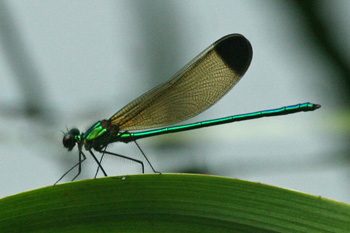 |
Jewelwings & Rubyspots
Highly metallic, green bodies; wings folded straight back along line of body. Found along
flowing streams and rivers. Three species in Cape May.
|
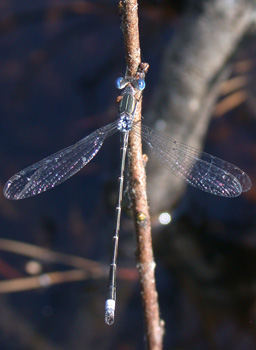 |
Spreadwings & Sprites
Spreadwings are readily told by the way that they hold their wings slightly spread (hence the
name!). Wings are narrowed and stalked at the base. Males generally have bright blue eyes and obvious, pincer-like appendages at the end of the
abdomen. Most species inhabit bogs and shallow or temporary ponds. Females are very hard to identify to species and a good specialist book should
be consulted. Sprites are included here as they look very similar to spreadwings, but fold their wings along their body like other damsels.
Sprites are very small. Six Spreadwings and two Sprite species in Cape May.
|
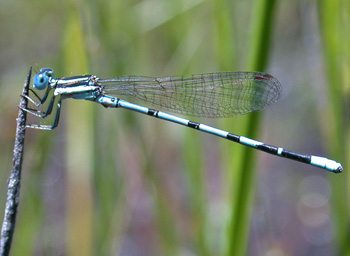 |
Dancers & Damsels
A rather mixed bunch of mid-sized damsels. Dancers are told from most other damsels by the obviously
long hairs on the legs. Most species tend to be predominantly dark blackish with bright blue on the tip of the tail, but this group includes a bright
red and our only purple species, as well as one which is mostly blue (pictured here) which could be mistaken for a bluet. Found in a range of wetland habitats.
Three Dancer and two Damsel species in Cape May.
|
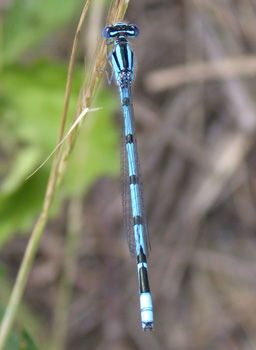 |
Bluets
As the name suggests, most bluets are predominantly blue in color. Several species are abundant in wetland areas
throughout Cape May and are easily seen in waterside vegetation. There are 14 species of Bluet in Cape May, including one red and one orange one. |
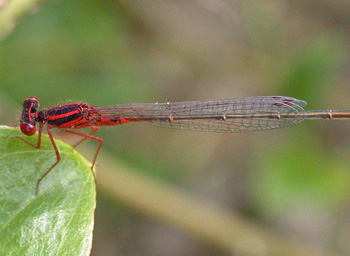 |
Bluets
As the name suggests, most bluets are predominantly blue in color - however, some are not! If you have a predominantly red or orange damselfly, you
may have one of the bluets, or perhaps a female Lilypad Forktail (try forktails below for this species). |
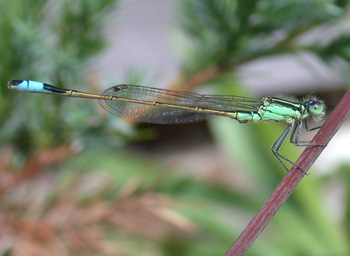 |
Forktails
A group of distinctly small and slender species which are most often found lurking furtively amongst dense vegetation,
often making them difficult to see well. Most males are green on the head and thorax, with bright blue on the tail; one is orange and one is blue on the
head and thorax. Females are rather variable and are best told by the typical forktail appearance and behavior. Five Forktail species in Cape May.
|
Dragonflies |
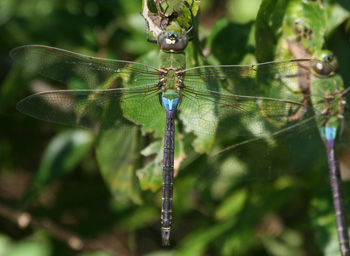 |
Darners
These are the brutes of the dragonfly world. Most are large, powerful looking insects that hunt actively along field edges,
over open water and along the edges of woods. When hunting, they spend long periods on the wing - which can be frustrating when you're trying to
identify them! Most males have blue-checkered abdomens and green on the thorax, but one is rather dull brown, one has a bright red abdomen and one
(the Dragonhunter) is black and yellow. Green and Swamp Darners migrate in impressive numbers through Cape May and can be seen well into November.
Ten species in Cape May.
|
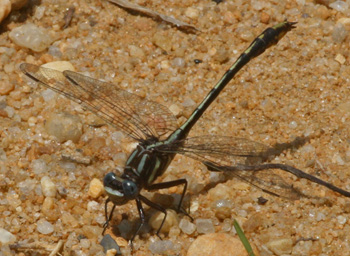 |
Clubtails & Sanddragons
Most male clubtails can be told by the widening of the body towards the far end of the abdomen. Females generally
don't have this widening so are a little trickier to identify. One species is reddish-brown on the abdomen, the others are blackish with yellow or
olive-yellow markings. These species mostly hunt from the ground and can be found on dirt trails through wet woods or along the edges of neighboring fields.
Four species in Cape May.
|
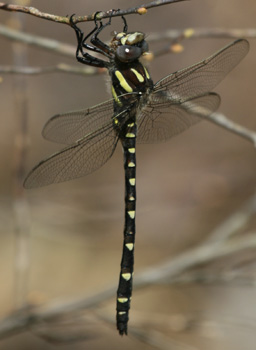 |
Spiketails & Cruisers
Long, slender-bodied species which are mostly shiny black with bright yellow markings.
Spiketails can be difficult to find, as they usually breed along small water courses in well-wooded areas, but can sometimes be found hunting along
field edges close to woodlots. River Cruisers hunt rapidly, low over rivers and streams and, like darners, are active hunters and thus often
difficult to pin down. Ten Spiketail and three Cruiser species in Cape May.
|
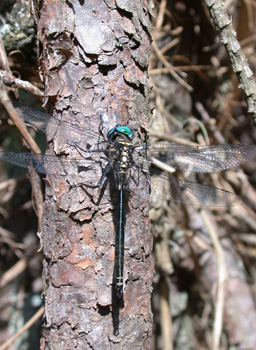 |
Emeralds
Mostly all dark, but with brilliant metallic green sheens to the thorax. Most species of emerald are active
hunters and the various species can be hard to identify as they rarely give a good view. Often to be found patrolling regular beats along woodland
rides or field edges. Four emerald species in Cape May.
|
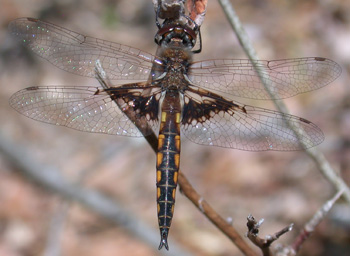 |
Baskettails
A group of dark brown dragonflies, with most species having orange-yellow spots along the sides of the
abdomen. Most species shows variable dark patches on the wing bases. Often wander far from water and can be found in feeding swarms wherever
feeding opportunities occur. Three species in Cape May (which includes the similar-looking Uhler's Sundragon).
|
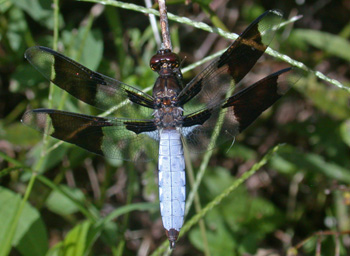 |
Smaller Skimmers & Corporals
In this group, most males are powder-blue on the abdomen and the females rusty with yellow spots.
The skimmers in this group have obvious dark patterns on their wings while the corporals have pale shoulder stripes. These species are all easily
seen as they hunt prominantly from the ground or the top of open perches. Six species in Cape May.
|
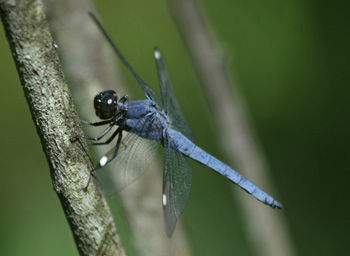 |
Larger Skimmers
The larger skimmers are mostly common to abundant throughout the summer months and are found in wet as
well as dry habitats. Males are blue or orange; females are yellowish or light brown, often with a pale stripe down the middle of the thorax, between
the wings. Though fast and active hunters, they usually hunt from perches and can be approachable. Eight species in Cape May (The very common Eastern Pondhawk is included
here as the blue male is very similar to male skimmers; the female is bright apple green).
|
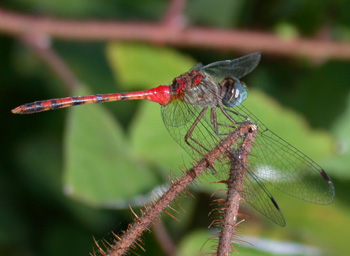 |
Meadowhawks
A group of predominantly red-bodied dragonflies, though females can be more orange-brown. Meadowhawks emerge
relatively late in the year - from July onwards and can be on the wing into November. They can be very common to abundant at favored wetlands where
they hunt from the ground or prominant perches. Six meadowhawk species in Cape May.
|
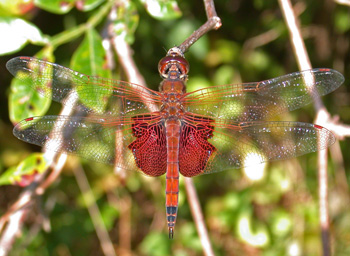 |
Saddlebags
Saddlebags species are easily recognised as such by the large, dark patches at the bases of the hind wings.
The are either mostly all red or all black and commonly occur in large swarms from late June onwards into November. They hunt actively on the wing
above head height, and are far more easily seen than photographed! Four saddlebag species in Cape May - though two are rare vagrants from the south.
|
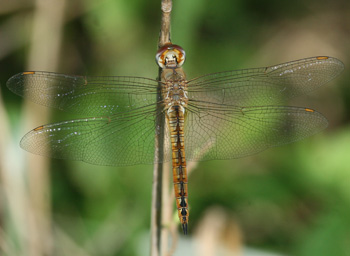 |
Gliders
Though they may not look it (being predominantly dull yellow-brown!) these are the impressive members of the family, wandering
far and wide across the planet. Gliders spend long periods on the wing and can be difficult to see at rest, but their rapid flights with many dips,
swoops and sideward rushes are distinctive once learnt. Best identification feature to tell them from other groups is the very deep base to the hind
wing, giving a broadly triangular shape to the wing. Two glider species in Cape May.
|
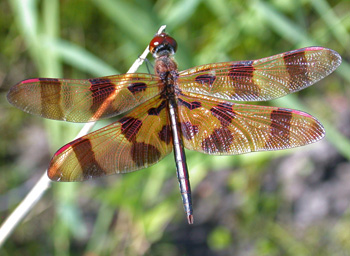 |
Pennants
Pennants are best told by the well-marked wings, as most species have patterns of dark spots and blotches on
all four wings. Two rarer species have smaller wing markings and blue bodies and could be mistaken for skimmers. Pennants hunt from prominant perches
around lakes or in dry meadows and are easily observed. Seven species in Cape May - including the very small Eastern Amberwing which resembles a small,
chubby pennant.
|
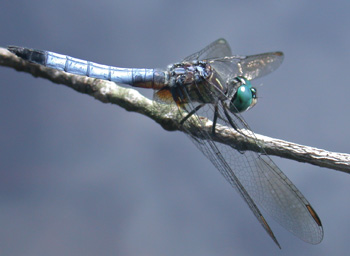 |
Three Tinies
Follow this link if you have a very small dragonfly that doesn't fit any of the above groups. Males are blue
or black, while females are banded or spotted with orange or yellow. The Blue Dasher is one of our commonest and most widespread species.
|